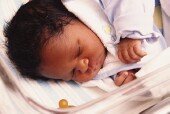
SUNDAY, Aug. 1 (HealthDay News) – Experts have long known that sudden infant death syndrome (SIDS) is more common in boys than girls, but a new study suggests that gender differences in levels of wakefulness are not to blame.
In fact, the researchers found that infant boys are more easily aroused from sleep than girls.
“Since the incidence of SIDS is increased in male infants, we had expected the male infants to be more difficult to arouse from sleep and to have fewer full arousals than the female infants,” senior author Rosemary S.C. Horne, a senior research fellow at the National Health and Medical Research Council of Australia, said in a news release. “In fact, we found the opposite when infants were younger at two to four weeks of age, and we were surprised to find that any differences between the male and female infants were resolved by the age of two to three months, which is the most vulnerable age for SIDS,” Horne said.
About 60 percent of infants who die from SIDS are male.
In the study, published in the Aug. 1 issue of Sleep, the Australian team tested 50 healthy infants by blowing a puff of air into their nostrils in order to wake them from sleep. At two to four weeks of age, the strength of the puff of air needed to arouse the infants was much lower in males than in females. This difference was no longer significant by ages two to three months, when SIDS risk peaks.
The frequency of arousals was similar for girls and boys at both ages.
“A failure to arouse from sleep is involved in the fatal pathway to an infant dying suddenly and unexpectedly,” explained Horne, who is also deputy director of the Monash Institute of Medical Research at Monash University in Melbourne.
So why the 60/40 ratio of male to female SIDS victims? Horne and her colleagues suggested that parents may more often try to calm restless male infants by putting them to sleep on their stomachs, which could help explain the higher rate of SIDS among males. Placing babies on their back to sleep reduces the risk of SIDS.
“Our study has highlighted the fact that SIDS is multi-factorial and that at present it is not possible to predict the deadly combination of internal and environmental factors that will result in SIDS,” Horne said. “Therefore, parents should be aware of the known risk factors and avoid them as best as possible by practicing the safe sleeping guidelines of sleeping babies on their backs, making sure their heads cannot be covered by bedding and keeping them free from cigarette smoke both before and after birth.”
More information
The Nemours Foundation has more about SIDS.

